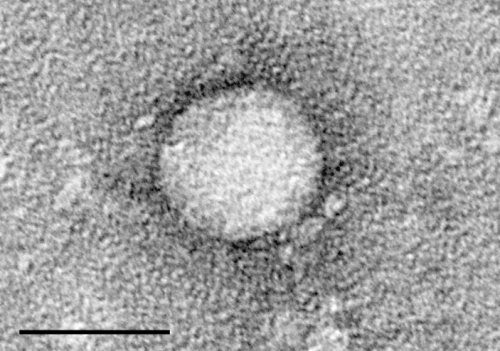Electron micrographs of hepatitis C virus purified from cell culture. Scale bar is 50 nanometers. Credit: Center for the Study of Hepatitis C, The Rockefeller University.
Due to the opioid epidemic, hepatitis C virus (HCV) is increasingamong pregnant women, resulting in a greater risk of perinatal transmission and HCV infection among children. Despite this increased prevalence, HCV-exposed infants are not adequately screened and many pediatric HCV infections remain undetected, according to a new study from researchers at Magee-Womens Research Institute (MWRI).
The results are reported in today's issue of the journal Pediatrics.
In the United States, perinatal transmission is the primary cause of HCV infection in children. According to the National Center for Biotechnology Information, at least 40,000 children are exposed to HCV during pregnancy annually, resulting in an estimated 2,700 to 4,000 new cases of pediatric HCV infections each year. Like hepatitis B infection, approximately 80 percent of children who acquired HCV infection through perinatal transmission develop chronic infection.
"Without appropriate screening, children at risk for perinatal transmission may remain undiagnosed until the child becomes symptomatic or has abnormal liver enzyme testing found incidentally," said senior author Catherine Chappell, M.D., Ms.C., OB/GYN, and assistant professor in the department of obstetrics, gynecology and reproductive sciences at UPMC Magee-Womens Hospital. "Delays in diagnosis could lead to delays in appropriate referrals and curative treatment, or even irreversible liver disease, such as cirrhosis or hepatocellular carcinoma."
Chappell and her colleagues at MWRI analyzed data on pregnancies and deliveries at Magee between 2006 and 2014, using data from the Magee Maternal and Infant (MOMI) database, a dataset which contains information on all births at the hospital from 1995 to the present. The women were identified and classified as HCV-infected or HCV-uninfected. Infant records linked to the HCV-infected pregnant women were identified and queried for the receipt of well-child services.
HCV-infected women were more likely than HCV-uninfected women to be younger than 30 years of age, white, insured by Medicaid and have opiate use disorder. Infants born to HCV-infected women were more likely to be preterm and low birth weight. Among the 1,025 HCV-exposed infants with available pediatric records, 31 percent received well-child services and among these, only 30 percent were screened for HCV.
There are several possible reasons for the failure to adequately screen infants perinatally exposed to HCV. Information regarding the maternal HCV diagnosis might not be accurately transferred to the pediatric record. If not transferred electronically, pediatric providers may fail to obtain accurate historical information regarding HCV risk exposures, as parents may selectively disclose stigmatizing behaviors such as past illegal drug use.
"Between 2006 and 2014, HCV prevalence increased by 60 percent. This is a wakeup call for providers to be aware of the increased risk of HCV in pregnant women and the affects it could have on their babies," Chappell said. "While more research needs to be done on why screening rates are so low, it is important providers are properly testing for HCV, especially in high prevalence areas, and that we have programs focused on identifying pregnant women with HCV during prenatal care."
Journal information: Pediatrics




















